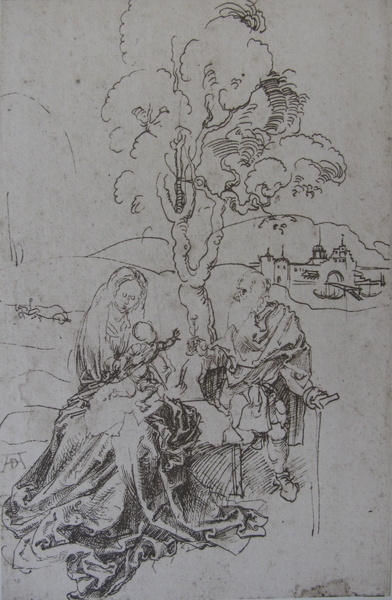The Holy Family
Summary
A reproduction produced by the Vasari Society of a drawing by Albrecht Dürer. The drawing shows a woman seated on a bench and holding a child in the left foreground, and a man standing in the right foreground looking at them. The woman is wearing a veil, and the drapery of her skirt extends up to the lower and left edges of the composition. The child is facing towards the front but looks at and gestures towards the man on the right. The man has a beard and is supporting himself with a stick in his left hand. In his right hand he is holding an object, which the child is reaching for. In the centre middle ground is a large tree, and to the left of this is a small horse and cart. In the right background is a river with boats and a bridge, and beyond this is a town. Text from the accompanying booklet produced by the Vasari Society: "No. 30 ALBRECHT DÜRER (b. 1471; d. 1528) THE HOLY FAMILY Collection of the Hon. A. E. Gathorne-Hardy. (From the Rogers and Malcolm Collections.) Pen and ink. 22.7 x 14.5 cm. (9 x 5 3/4 in.) The Virgin sits on a bench under a tree, holding the Child, who almost throws himself from her arms in his eagerness to grasp a flower offered by Joseph. In the distance on the left are a horse and cart, and on the right a port on river, lake or sea, backed by hills. Some portions of the drawing, notably Joseph's head and all the upper part of Mary's figure to the waist, are in a browner ink than the rest. Dürer's monogram has been added later in a grey ink. No watermark is visible, the drawing being backed with stout paper, which also covers the extreme edges of the original sheet. In attempting to place a drawing of this class we must guard against mistaking slightness of execution for evidence of earlier date. The sketchy treatment of the landscape and the heads belong to a later, not an earlier, stage in Dürer's development than the drawings of the Wanderjahre ... in which his dependence on Schongauer is still strongly marked. The drapery of the Virgin, on which most time and pains have been spent, is also the part of the design which most suggests an earlier date; it may actually have been first drawn for a different purpose, the rest of the composition, as we see it, being an aftertthought. It resembles the drapery in the group of studies connected with the engraving, La Vierge au Papillon, B. 44 (Berlin, Erlangen and Mayer Collections), which are generally ascribed to the years 1491-1493, the engraving itself being of somewhat later date (1494-1495?). But Mary's robe, though similar in its arrangement and folds to the group in question, and even to the Bonnat drawing, L. 346, is not drawn with the old engraver-like precision. When we turn to the heads, the difference in style is much more marked. The stage in which Dürer drew large prominent eyes nearly closed by heavy eye-lids (British Museum, St. John the Baptist, Mayer and Rodrigues Madonnas; the latter now at Berlin) is evidently past. The slightly sketched forked beard of Joseph, the peg-shaped nose and round, expressionless eyes of Mary, are features that appear at least up to 1500 in Dürer's hastier sketches. Both may be found in the Adoration of the Magi in the Bonnat collection, L. 348, the eyes and nose also in the Bremen drawing, Dürer Society, VIII, 5 (dated too early, in my opinion, by Dr. Pauli), in some of the nymphs in the background of the Albertina drawing, L. 456, the Windsor drawing, L. 389, and even in the Meerwunder engraving, B. 71; all works of the end of the century. In the Oxford drawing, The Pleasures of the World (Part II of Mr. Colvin's publication), there are similar eyes, but an acute angle serves for a nose, as in the jester of the slight sketch on the back of L. 209 (D. S., V, 5). The Oxford drawing is dated by Dr. Friedländer about 1496. That is the earliest possible date, in my opinion, for the present drawing, which I would prefer to put later, though in any case before 1500. The nearest parallel to the tree may be found in the large woodcuts, 'Ercules' and The Knight and Man-at-Arms; it also resembles the tree in the allegorical drawing at Windsor. Such buildings by the sea, with a jetty and boats, make their first appearance, so far as I know, in the London sketch already mentioned, but they are of common occurence in the large woodcuts of the late nineties. Joseph's clumsy left hand, and the staring mask of the Virgin are defects which must be set against the spirited background and the charming invention of the eager Child. The editors of Handzeichnungen alter Meister aus der Albertina, &c., have recently attributed this drawing to the anonymous artist of two sketches for a composition of the Virgin and Child with St. Anne, at Budapest (XII, 1131). There are superficial points of resemblance: a similar formula is adopted for Mary's features, and the uncertain drawing of the two right hands, St. Anne's and St. Joseph's, is curiously alike; but there, so far as I see, the resemblance ends. It is impossible that the Budapest drawings should be by Dürer, almost impossible that anyone but Dürer should have drawn the Holy Family before us, though it has weak points, and lacks the unity of style which would characterize a composition thought out and recorded all at once. C. DODGSON."
Object Name
The Holy Family
Creators Name
Date Created
1905-1906
Dimensions
support: 45.6cm x 38.1cm
accession number
1932.69/30
Collection Group
Medium

